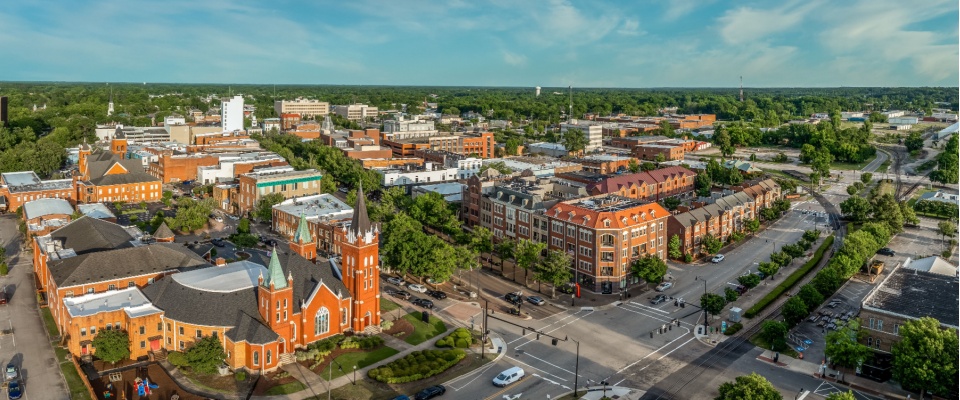America’s move-easy hotspots: Renters change homes most frequently in the Southeast
Share this article:
For many American renters, the reasons for moving are often related to finding jobs and better housing — trends that still hold firm even with the rise of remote work. But setting aside why they move, how frequently do renters in the U.S. move from one apartment to another? Better yet, which are the nation’s move-easy metros — where renters typically move to a different apartment in less than two years from signing a lease?
To find out, we crunched available IPUMS ACS data on 105 U.S. metro areas, focusing on local trends for short renter tenancies (up to two years). We also factored in changes in the local share of renters and rental housing supply to contextualize local renters’ mobility.
Key takeaways:
- Renters moving to a different apartment in less than two years make up 38% of all apartment dwellers on the move.
- Austin, TX, is the #1 move-easy metro with 54% of local renters moving to a new address in under two years.
- Frequent movers skyrocket in Charleston, SC, whereas the nation’s hottest rental markets see fewer renters moving within two years of signing a lease.
- Hyper-mobile Gen Z renters make up 72% of movers in this age group; meanwhile, 43% of Millennial renters switch apartments within two years.
Nationwide, renters who move to a different apartment in under two years represent 38% of all apartment dwellers on the move. Furthermore, Gen Z renters moving very frequently in their areas make up 72% of movers in this age group.
Leading the trend of renters changing their address very frequently, Austin, TX, emerged as the nation’s #1 move-easy metro with over 50% of its renters moving to a different apartment in less than two years between 2018 and 2023. Still, the Southeast dominates our ranking, boasting 12 entries in the top 30 metros with very high residential mobility rates.
Also, Charleston, SC, saw the fastest increase in very frequent movers, with apartment dwellers who changed their address in under two years skyrocketing by almost 44%.
Select any green metro area on this interactive map to view its renter mobility score and how it ranks nationally:
Renters moving very frequently are the largest group of people moving to a different apartment in their area
Renters moving within just two years from signing a lease were the largest group in the housing churn in 2023, making up 38% of all renters who moved in their area, down slightly from 40% five years prior. Similarly, the actual number of people making these quick moves also dropped just slightly, from about 17.4 million to 17.3 million.
So, what drove the high number of short-term moves between 2018 and 2023? Americans faced major economic swings during those five years. First, early pandemic job losses pushed many renters to move simply to save money — maybe downsizing or heading back home. Later, the economic recovery, “Great Resignation,” and industry shifts led others to move for new jobs, while ongoing uncertainty sent some looking for more affordable areas with a reasonable cost of living and housing.
At the same time, lockdowns changed many renters’ housing preferences. Specifically, the need for more space to accommodate home offices or easy access to nature pushed renters to quickly find different places, even after short stays.
Remote work was also key. Initially, it allowed moves based on lifestyle or cost, not just commute. But then, return-to-office mandates sometimes prompted quick moves back near jobs or required job changes in order to remain remote, thereby causing further quick moves. Later, the end of pandemic-era eviction moratoriums also played a part in quick moves.
Gen Z are the most frequent movers, but patterns are shifting
Gen Zers are overwhelmingly frequent movers among American renters. In 2023, the vast majority (72%) of Gen Z movers had lived in their previous home for two years or less. It’s worth noting that between 2018 and 2023, millions of Gen Z members entered their prime renting years, which explains the massive surge in the sheer number of movers from this generation. For example, Gen Z renters moving within just two years grew by more than 3.7 million during this period.
Interestingly, while the number of Gen Z movers skyrocketed, their pattern of moves saw a slight shift: The share of hyper-frequent movers fell from 83% in 2018 to 72% in 2023, but this difference likely pushed movers into longer stays. Consequently, despite a slight moderation, short-term tenancies prevail among Gen Z renters.
This high frequency of moving largely stems from Gen Z’s typical life stage during these years: navigating college, early careers, relationship changes, and establishing independence — all common triggers for moving into a new place. Granted, the ongoing economic uncertainties, shifting housing needs driven by the pandemic (like needing extra space to set up a home office), and fluctuating remote work policies likely added further layers, encouraging or prompting frequent moves.
By comparison, Millennials moved less often in 2023 with 43% of them doing so within two years. This highlights how Millennials — who are generally further along in careers and personal lives — have different priorities, likely influenced by stability needs and market pressures that are distinct from the typical Gen Z renter experience.
Gen X and Baby Boomers showcase even less frequent moves during those five years. For both groups, the dominant trend is staying put, reflecting the greater stability that’s common during these life stages.
Austin, TX, is America’s #1 move-easy metro
1. Austin, TX
Austin, TX, is the nation’s #1 move-easy hotspot, with a significant 54% of renters moving to a different apartment in less than two years. More precisely, the share of renters moving to a different apartment this frequently surged by 34.4% between 2018 and 2023.
Austin has been one of the fastest-growing major metro areas in the U.S. for years, attracting residents from across the country and beyond. In fact, the share of renters in Austin grew by 5.8% in five years. Accordingly, this fueled demand for apartments, and developers took note by boosting the local supply by 32.4% between 2018 and 2023. This surge in apartment construction has placed the metro at #2 nationally for supply growth during those five years.

But, while the new apartments in Austin provide more options, all this new supply has likely led to incentives, giving renters plenty of reasons to shop around and move very frequently in search of more affordable housing or better locations.
Looking at who moves most also reveals a generational split, and Gen Z renters are exceptionally mobile: 83% moved within a two-year period as of 2023 (up slightly from 82% in 2018), underscoring Austin’s appeal as a top destination for Gen Zers on the move. Interestingly, while most Millennial renters in Austin (54%) also move homes frequently, their rate has dropped from 63% five years prior.
2. Provo, UT
Provo, UT, holds the #2 spot nationally for very frequent movers, with 60% of its renters choosing a new home in under two years — the highest share among all metros analyzed, placing it second for high mobility nationwide. This high rate of frequent moving also increased by a solid 21.9% between 2018 and 2023.
What makes Provo a move-easy hotspot? First, the metro’s rental landscape experienced significant shifts during those five years: The share of renters surged by 30.6%, while the supply of apartments in Provo increased by almost 33%.

These changes are heavily influenced by Provo’s large, transient student population attending Brigham Young University, as well as the rapid expansion of its “Silicon Slopes” tech sector, both of which constantly attract renters in need of housing.
Interestingly, while both Gen Z (80%) and Millennial (54%) renters here remain highly mobile, their rates actually dropped significantly from 2018 levels (down from 94% and 70%, respectively). This suggests Provo’s move-easy appeal is fueled less by restlessness and more by the sheer volume of young renters cycling through this major college town and thriving tech hub.
3. Charleston, SC
Charleston, SC — America’s best city for renters — secures the #3 spot among the top move-easy metros, with 55% of its renters moving to a new place within two years.
What’s really turning heads, though, is how fast this trend accelerated: The share of very frequent movers skyrocketed by a massive 43.9% between 2018 and 2023, placing Charleston at #1 for high residential mobility.

Furthermore, Charleston’s increased mobility is uniquely multigenerational. While Gen Zers make up a whopping 88% of those moving very quickly (down from 91% in 2018), the truly dramatic jump in frequent moves comes from Millennials (climbing to 59% from 50% five years prior) and even Baby Boomers (rising to 33% from 24% in 2018).
4. Fayetteville, AR
Coming in fourth in our ranking of the top move-easy metros is Fayetteville, AR, with nearly half (48%) of renters moving very frequently — up by a solid 23.5% since 2018.
It’s worth noting that this high turnover is happening in the nation’s hottest small rental market, where apartments are hard to come by yet the booming economy keeps attracting newcomers, thereby driving demand for housing. In particular, during 2018 and 2023, the metro’s population of renters grew by 12.4%, while the supply of apartments in Fayetteville grew by 14.1%.

A lot of this churn is driven by the University of Arkansas’s large and growing student body. At the same time, the booming Northwest Arkansas economy keeps pulling in young professionals who often rent whatever they can get their hands on first in this red-hot apartment market.
While frequent moving overall went up, the rate actually dropped for younger renters compared to 2018: Gen Z’s rate fell to 75% (from 91%) and Millennials dipped slightly to 45% (from 48%). In this case, the increase in frequent moves during those five years seems to be less about individual renters growing restless and more about the growth in the number of young students and workers choosing to call Fayetteville home.
5. Denver
Denver comes in at #5 nationally for renters on the move with more than half (53%) of apartment-dwellers here switching homes quickly. The share of renters moving within two years here grew quite a bit — up 19.3% between 2018 and 2023 — to keep Denver high on the list of move-easy metros.
Interestingly, this happened even as the share of renters dipped slightly by 2.6% since 2018. But, the supply of apartments in Denver didn’t grow as fast as it did in other move-easy hotspots, inching up by a moderate 9.8% during those five years.

Still, Denver’s a big draw with its job opportunities and outdoor lifestyle. This popularity — combined with fewer new units popping up in five years — keeps the rental scene buzzing, likely encouraging renters to explore more affordable options when their lease is up as they look for the right fit.
But, who’s moving most frequently in Mile High City? While the super-mobile Gen Z renters actually moved a bit less often recently (down to 78% from 86% in 2018), Denver’s Millennial crowd of frequent movers account for a staggering 60% of renters in this generation (only slightly down from 61% in 2018). So, it seems this consistent moving by Millennials is really what keeps Denver near the top for mobile renters.
6. Salt Lake City
The second Utah location on our list, Salt Lake City ranks sixth among America’s top move-easy metros. Here, just more than half (51%) of renters are eager to find a new place within two years — and even more people moved this frequently between 2018 and 2023 with their share jumping by a solid 25%.
Also part of “Silicon Slope,” Salt Lake City emerged as a prime spot for frequent moves even as its population of renters inched up by a modest 2.8% during those five years as its housing stock grew by 17.8%. Here, the area’s expanding tech sector, the pull of local universities and its general appeal as a cool place to live in the West keep things lively for frequent movers. Salt Lake City is also an emerging AI job hotspot and, as such, consistently draws venture capital investment into tech startups.

Digging into the generations, Gen Z renters stayed super mobile with around 78% moving within two years, which is pretty much in line with 2018 levels. Millennials, on the other hand, slowed down a little during those five years: Their share of frequent movers dropped to 52% from 57% five years prior.
That said, even with Millennials moving less in the first two years since signing a lease, the overall number of frequent moves still surged — likely because so many young renters are drawn to SLC for school or work, keeping the rental scene active.
7. Boise, ID
Boise, ID, ranks #7 nationally for renters making quick moves, with nearly half (48%) changing places within two years. Notably, the rate at which renters in Boise move frequently increased significantly between 2018 and 2023. The share of these frequent movers rose by a staggering 38.4% during that timeframe.
This trend coincided with Boise’s economic growth, fueled by an expanding manufacturing and semiconductor industry that keeps pulling in many highly skilled professionals seeking a balance between their careers and a laidback lifestyle.

Even so, the overall percentage of people renting apartments in Boise increased only modestly during those five years, whereas the supply of apartments grew by 13.7%. This suggests that, with more options available, renters in Boise began moving more frequently, perhaps seeking better deals or locations.
What’s more, this churn wasn’t confined to just one age group: As more Gen Zers entered the rental market, they went from moving often to moving constantly. For example, the share of frequent movers in this generation nearly doubled to 86% from 49% in five years. Millennials also became more mobile, with frequent movers in this age group increasing to 49% in 2023 from around 45% five years prior.
8. Colorado Springs, CO
Colorado Springs lands at #8 among the top 10 move-easy metros in the U.S., but punches above its weight in one key area: An impressive 56% of its renters move to a new place within just two years — a share only surpassed by Provo.
And, although this high mobility rate did increase between 2018 and 2023, it grew by just 8.7%. That’s a very modest increase compared to other move-easy hotspots, suggesting that frequent moving was already common in Colorado Springs even before 2018.

What’s driving frequent moves in Colorado Springs? A major factor is the large military community, with personnel frequently relocating due to assignments. Additionally, the city’s growing job market — particularly in aerospace and tech — combined with its lifestyle appeal, continues to attract newcomers. This happens even as the area saw a slight dip in its renter population, which shrank by 1.8% between 2018 and 2023, all while the supply of apartments in Colorado Springs grew by 11.1%.
Looking closer at the breakdown by generation reveals that while Gen Z (85%) and Millennial (62%) renters are still very prone to moving frequently, their individual shares actually eased back during those five years — down from 92% and 68%, respectively, in 2018. Therefore, the slight overall rise in frequent moves likely stems from the constant, built-in shake-up associated with the military population, as well as the steady arrival of new renters, rather than increasing restlessness across the board.
9. Orlando, FL
Ranking ninth is Orlando, FL, with nearly half (46%) of its renters moving within a two-year window. Here, the share of frequent movers also increased significantly between 2018 and 2023, jumping by more than 20%.
Notably, Orlando boasts one of the highest shares of renters (35%) among the top 10 move-easy metros — only matched by Fayetteville, AR — yet its renter population increased by just 3.6% in those five years.

The high share of renters who rent, coupled with frequent moves, fits Orlando’s profile as a bustling area fueled by tourism, hospitality, and significant in-migration. That’s because renters arriving for abundant service-sector jobs or seeking sunshine find a market that’s also adding housing options. Accordingly, the supply of apartments in Orlando grew by 23.7% between 2018 and 2023, keeping the rental scene lively for renters on the move.
Here, as well, the story behind the increased share of frequent movers isn’t renters becoming individually more restless. As a matter of fact, both Gen Z (now 76%) and Millennial (now 50%) frequent-moving rates actually dipped from their 2018 levels of 80% and 59%, respectively. Instead, the rise in frequent moves appears to be powered by the sheer volume of Orlando’s renter pool within an economy supporting a mobile workforce.
10. Des Moines, IA
Rounding out the top 10 is Des Moines, IA, the only Midwest location among America’s elite move-easy metros. Despite ranking at the bottom of the list, Des Moines boasts a surprisingly high share of frequent movers with 55% of its renters moving to a new place within just two years — matching Charleston, SC’s share of frequent movers.
However, the growth in quick movers (up 12.1% since 2018) was more moderate compared to other move-easy metros, only surpassing Colorado Springs’ increase.

Even so, Des Moines stands out with the largest decrease in its renter population (down by 10.6%) among the top 10 move-easy hotspots. That’s likely due to the fact that, in recent years, there has been surge in resale houses in the area, as homeowners who previously held onto low-interest mortgages began to sell. This allowed aspiring homeowners to buy, potentially explaining the dip in the city’s renter population. At the same time, the supply of apartments in Des Moines grew the slowest between 2018 and 2023 (a mere 5.3%).
Des Moines’ high share of frequent movers is largely due to a generational shift. While Millennials slowed their moving pace considerably (down to 54% from 65% in 2018), hyper-mobile Gen Z renters hit the accelerator, soaring to 82% (up from 58% five years prior). This younger generation, perhaps attracted by affordability and entry-level jobs, appears to be the main engine driving Des Moines’ move-easy appeal.
Frequent movers skyrocket in Charleston, SC — unlike in the nation’s hottest rental markets
While Charleston, SC, ranked third nationally, it experienced the most dramatic surge in renters moving within two years: Between 2018 and 2023, the share of frequent movers in Charleston skyrocketed by an impressive 43.9% — marking the fastest increase in hyper-mobile renters nationwide. This surge in frequent moving occurred even as the metro’s overall share of renters dipped slightly by 4.7% during those five years, while the supply of apartments in Charleston grew by 13.8%.
So, what’s behind all the churn? Largely, it’s Charleston’s strong and diverse job market — driven by industries like tech, aerospace and tourism — combined with a high quality of life that appeals across generations. This likely drives competition and frequent moves among renters looking for better options, making Charleston a hotspot for hyper-mobile apartment dwellers.
In addition to that, Charleston was named the best city for renters two years in a row in both 2023 and 2024, thanks to its robust local economy and relative affordability. With a cost of living below the national average and abundant career opportunities — especially from major tech employers that have earned the city the nickname “Silicon Harbor” — it’s easy to see the appeal. The city’s booming tourism sector also contributes plenty of jobs.
By contrast, the hottest rental markets see fewer renters making quick moves. For example, in Miami — #31 among America’s move-easy metros — very frequent movers account for 38% of all renters. While Miami saw a small, 6.8% uptick in quick moves between 2018 and 2023, frequent renters in Chicago (#64) slightly decreased by 1% to reach 37%. Meanwhile, in Grand Rapids, MI (#68), where 42% of renters move very frequently, quick moves actually became less common, declining by 7.1% in five years.
This declining trend in quick moves in very competitive rental markets boils down to two main factors — occupancy rates are sky-high and more people are renewing their leases. Plus, the hassle associated with moving to a new place, application costs and the financial risk of moving so often outweigh potential benefits when better, readily available options are scarce.
The Southeast has most move-easy metros in top 30, with none from the Northeast
Zooming out regionally, the Southeast dominates, by far, with 12 of the top 30 move-easy metros, followed by the Southwest with six entries. The top 30 also includes four move-easy metros from the Mountain region, three from the Pacific, three from the West and two from the Midwest.
Notably absent from the top 30 is the Northeast. Renters in this supply-constrained region tend to hold onto their leases once they find an apartment that fits their needs.
Looking closer at the top 10, the regional distribution changes slightly. The Southeast and the West are at a tie with three metros each, followed by the Mountain region with two entries. The Southwest and Midwest each feature one metro, while the Pacific region is not represented in the 10.
Leading the move-easy metros in the Southeast is Charleston, which claims third place nationwide. Next up is Fayetteville (#2 in the region and #4 in the U.S.); followed by Orlando (#3 regionally and #9 nationwide.); Nashville, TN (#4 in the region and #11 in the U.S.); Fort Myers, FL (#5 in the region and #18 in the U.S.); Chattanooga, TN (#6 regionally and #19 nationwide); and Jacksonville, FL (#7 in the region and #20 in the U.S.). Rounding out the top 10 in the Southeast are Raleigh, NC (#8 in the region and #21 nationwide); Charlotte, NC (#9 in the region and #23 in the U.S.); and Sarasota, FL (#10 in the region and #26 in the U.S.).
Over in the Southwest, Austin takes the first spot and is also the #1 move-easy hotspot in the U.S. Following at a great distance is a string of Texas locations: San Antonio (#2 in the region and #12 nationwide); Houston (#3 regionally and #13 in the U.S.); McAllen (#4 in the region and #14 nationally); Dallas (#5 in the region and #15 in the U.S.); and El Paso (#2 regionally and #24 in the U.S.).
In the Mountain region, Denver claims first place (while also ranking fifth in the U.S.), followed closely by Colorado Springs (#2 in the region and #8 nationwide). Also featured in the top 30 are two Arizona cities: Phoenix (#3 in the region and #25 in the U.S.) and Tucson (#4 regionally and #28 nationwide).
To see the move-easy hotspots in the rest of the U.S., check out the breakdown by region.
Methodology
RentCafe.com is a nationwide apartment search website that enables renters to easily find apartments and houses for rent throughout the U.S.
This report tackles the most “move-easy” metros, or high residential mobility metros where renters move into a new place within two years of signing a lease. To compile this report, the research team analyzed 2023 and 2018 American Community Survey (ACS) data via IPUMS across the 105 largest metropolitan areas by population in the contiguous U.S. The metro areas and regions are defined according to the U.S. Census Bureau.
The metros were ranked based on a metro-level high residential mobility score, or “move-easy” score. Full points were awarded to the most move-easy metro for a particular metric, while the zero-point level was set at the worst metro’s value. The metro that obtained the highest total score was awarded 100 points and all total scores of the following metros were adjusted accordingly. Metros that lacked sufficient information regarding specific metrics were awarded zero points.
To calculate each metro’s move-easy score, we ranked them according to three metrics, each with two submetrics (their averages as of 2023 versus 2018).
1. High Mobility:
- High Mobility Rate (%) — Maximum score: 40 points
The share of renters who moved into a new place within two years since signing a lease.
- Change in High Mobility Rate (%) — Maximum score: 30 points
Five-year comparison (2023 versus 2018) between high mobility rates on a metro level.
2. Share of Renters:
- Total Share of Renters (%) — Maximum score: 10 points
The share of renters out of a metro’s total population.
- Change in Total Share of Renters (%) — Maximum score: 5 points
Five-year net comparison (2023 versus 2018) between the total share of renters out of a metro’s total population.
3. Supply:
- Total Number of Rental Units (%) — Maximum Score: 10 points
The share of rental units out of a metro’s total number of housing units.
- Change in Total Number of Rental Units (%) — Maximum Score: 5 points
Five-year net comparison (2023 versus 2018) between the total number of rental units out of a metro’s total number of housing units.
Fair use and redistribution
We encourage you and freely grant you permission to reuse, host, or repost the research, graphics, and images presented in this article. When doing so, we ask that you credit our research by linking to RentCafe.com or this page, so that your readers can learn more about this project, the research behind it and its methodology. For more in-depth, customized data, please contact us at media@rentcafe.com.
Share this article:
Veronica Grecu is a senior creative writer and research analyst for RentCafe. With more than 14 years of experience in the real estate industry, she covers a variety of topics in the apartment market, including rental competitiveness, new construction and other industry trends. Her work has been featured in top publications like The New York Times, The Washington Post, The Wall Street Journal, The Philadelphia Inquirer, The Miami Herald, CNN, CNBC, and more. Prior to RentCafe, Veronica was involved in producing real estate content for Multi-Housing News, Commercial Property Executive and Yardi Matrix. She holds a B.A. in Applied Modern Languages and an M.A. in Advertising and PR.
The Ready Renter has your back
Tips, news, and research curated for renters, straight to your inbox.




Related posts
Subscribe to
The Ready Renter newsletter







